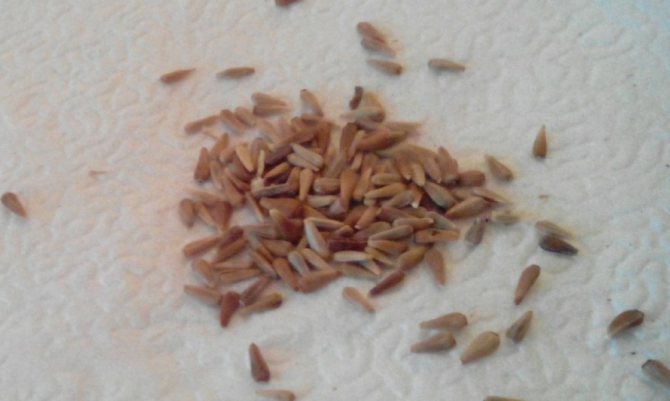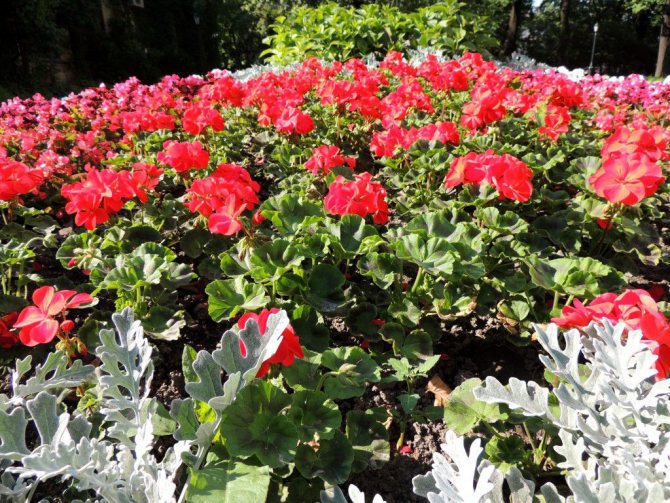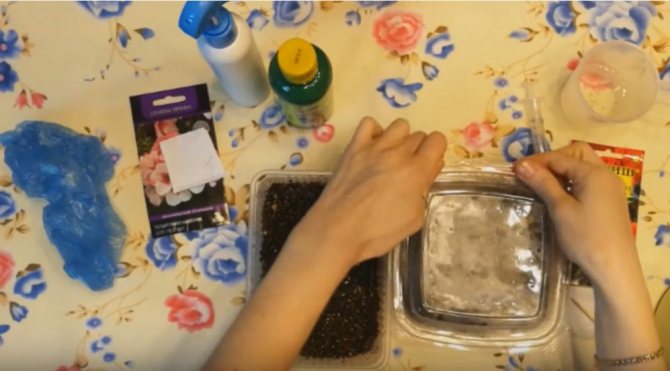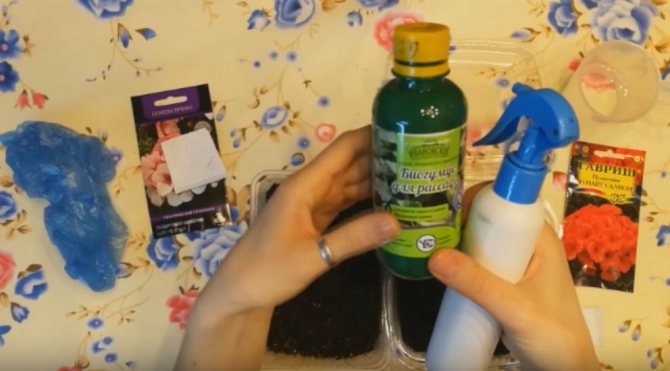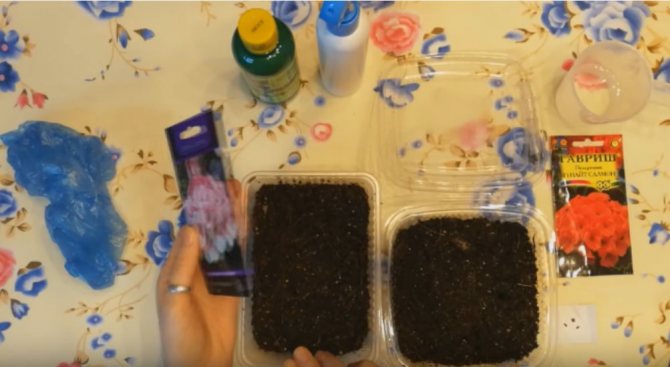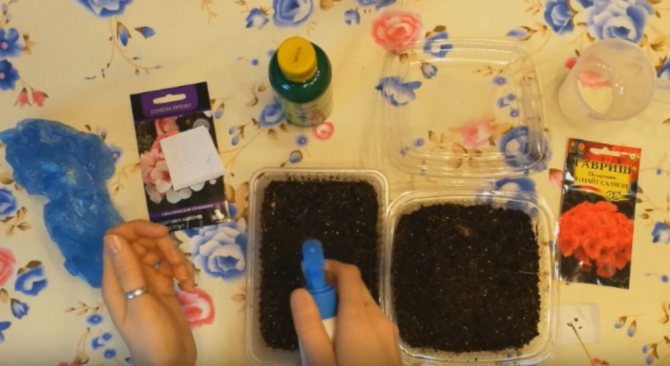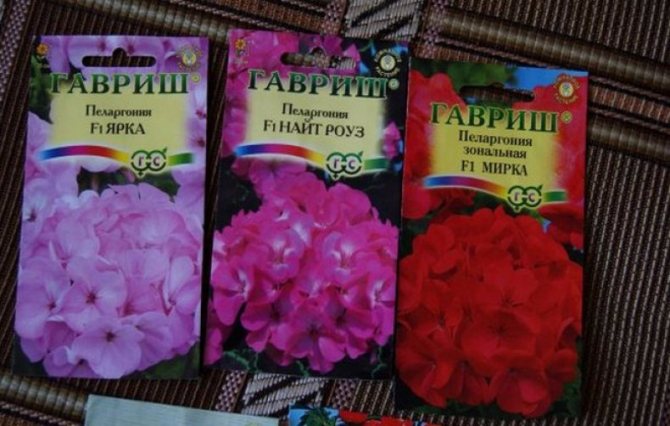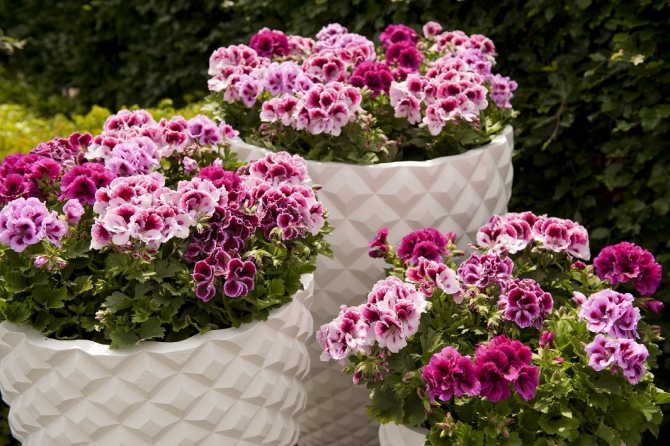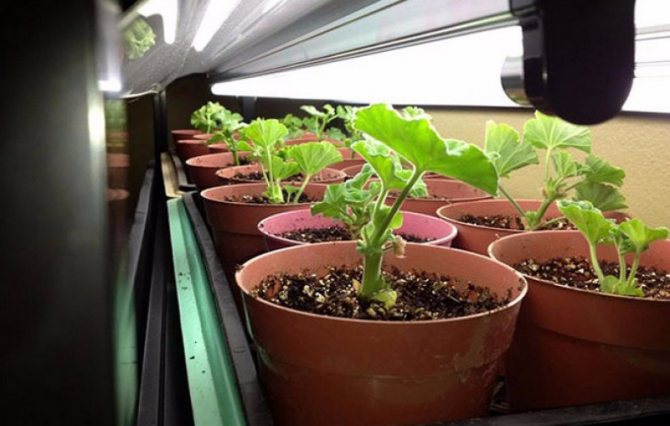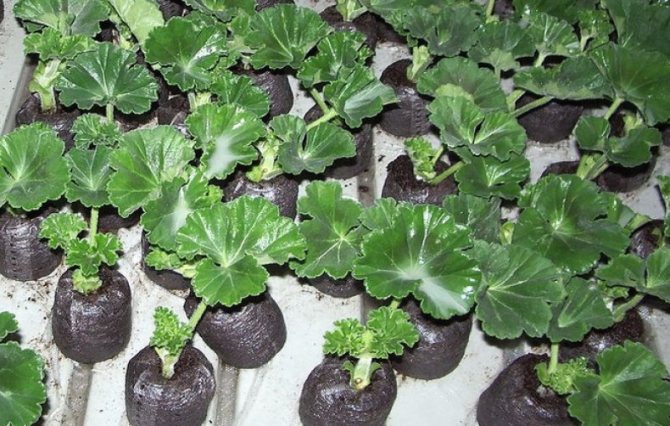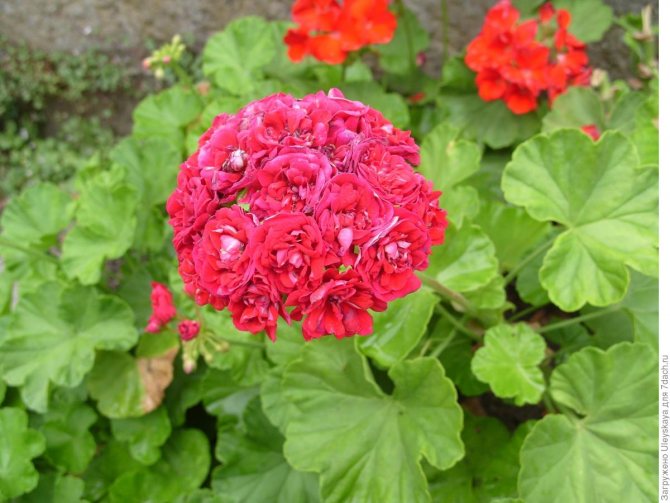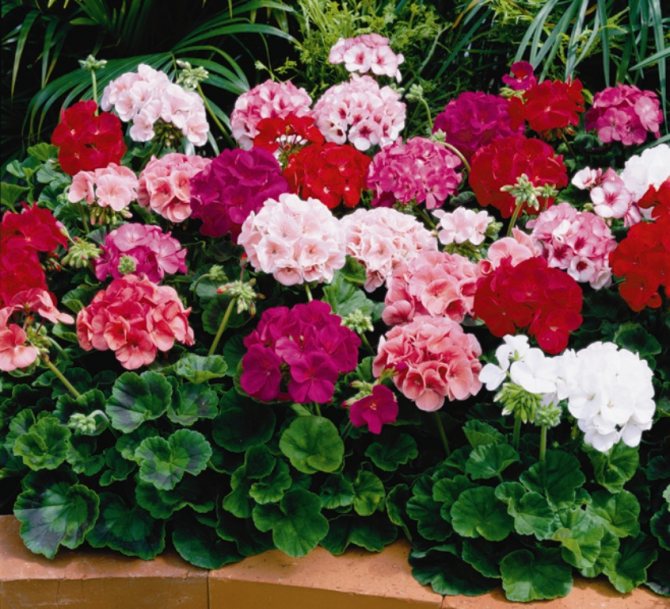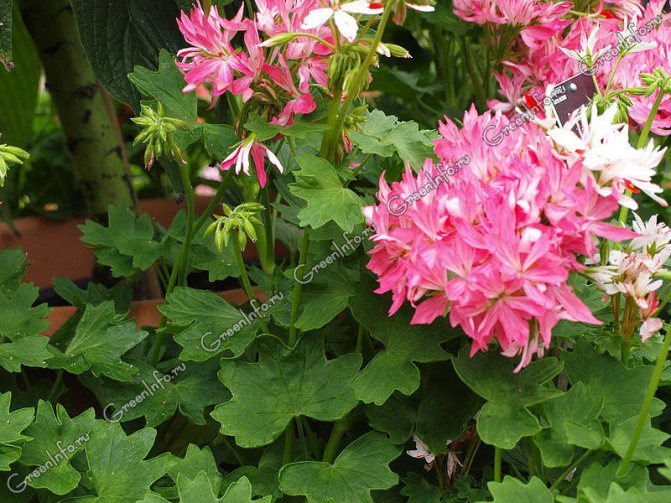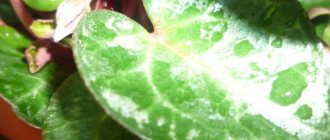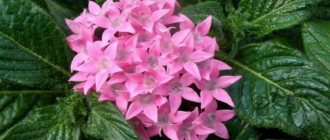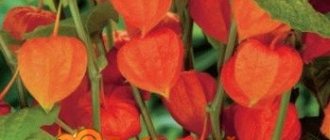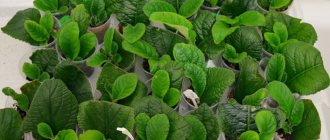Geranium (pelargonium) zonal - a beautiful plant with lush greenery throughout the year and beautiful flowering from spring to late autumn. It is still familiar to our grandmothers - it is difficult to imagine a house where the caps of geranium inflorescences would not adorn the windowsill. Back in the early 18th century, these flowers appeared - first in greenhouses, and then simply in the houses of the British. From England, zonal geranium spread throughout Europe and at the end of the 18th century reached Russia.
Travelers and colonialists brought it from southern Africa. A large number of species were brought and domesticated from the Cape, such as amaryllis, succulents and pelargoniums, which are mistakenly called geraniums in our country. Currently, there are about 250 species of pelargonium. Pelargoniums are so diverse that they were conventionally divided into three groups. Large-flowered, thyroid or ivy-leaved and zonal pelargoniums, which are also called garden.
These are the highest and most resistant varieties for summer planting in open ground in central Russia.
In May, they can already be transplanted into flower beds, and when the temperature at night begins to drop to 10 degrees, the flower is dug up and taken indoors. Unlike royal pelargonium, zonal geranium will perfectly respond to such a sharp change of "home".
All types of pelargonium, including zonal geranium, have medicinal properties. They contain essential oils and emit phytoncides, are able to survive in rooms where people smoke and even purify the air.
Pelargoniums are also endowed with esoteric abilities. Superstitions speak of their ability to positively influence the well-being of the owner, harmonize family relationships and help in finding a second half. Men decorated costumes with boutonnieres of these flowers, and women took dry petals of white pelargonium on a date to fall in love with their chosen one.
Pelargonium flowers description, photo
Know! Its essential oil is widely used in cosmetology, aromatherapy, when creating perfumery products, as well as in folk medicine. There are about three hundred species of this plant in the world. Let's consider the most popular of them:
- zonal;
- ivy;
- royal;
- ampelous.
Geranium is relatively not whimsical. It does not require close attention to itself and will not bring hassle to a novice gardener. However, this cannot be said about royal pelargonium.
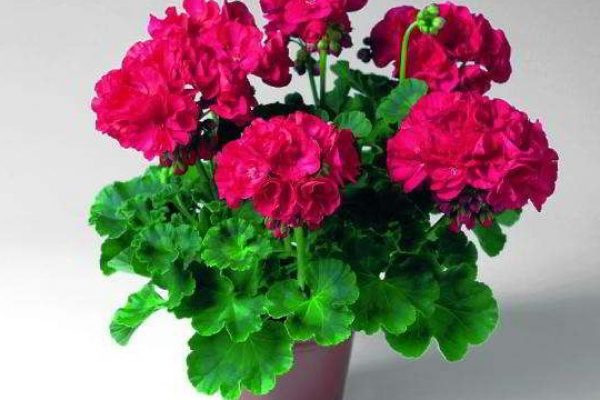
P. zonal


P. ivy
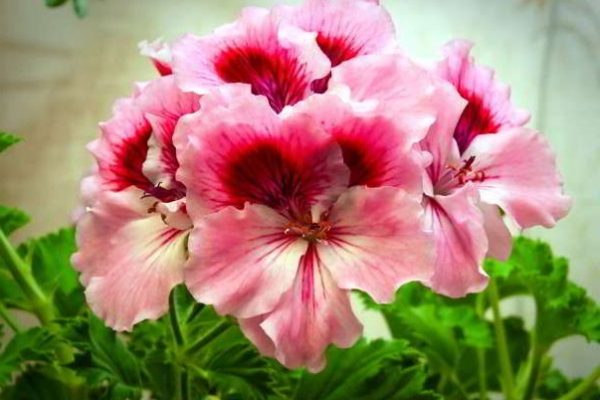

P. royal


P. ampelnaya
Soil mix
Since the planting material is dry, planting pelargonium seeds requires loose soil. It should be of medium density and not too clayey. You can buy ready-made soil at the store, there is a special mixture for geraniums, or you can prepare it yourself at home.
To do this, you need one of the following proportions:
- peat, sand, turf (1: 1: 2);
- sand, peat (1: 1);
- perlite, peat (1: 1).
It is best to use the first version of the mixture, since with a two-component composition of the soil, it will be necessary to care for geraniums in the future more carefully.
Preparations for growing pelargonium seeds
Pelargonium is best grown by seed. Most often, flowers grown from seed bloom better and much more abundantly than geranium grown from cuttings.If the seeds were taken from hybrid varieties, then during germination, a flower that is completely different from the “parents” may appear. However, most gardeners prefer to propagate it by cuttings.
The necessary conditions
Pelargonium has a southern sill, but no direct sunlight. The temperature of the content in the summer should be no higher than 24 degrees, in the winter not lower than 14. The soil should be loose, well-drained. Watering should be moderate but constant. Geranium does not like stagnant water. During the growing season, it is fed twice a month with liquid fertilizer.
Sowing dates
Sowing pelargonium can be done all year round, but only if additional lighting is provided. If this is not possible, the best breeding time is spring, summer.
Seed preparation for sowing
Before sowing, they need to be prepared. If they were obtained from home geranium, then they must be cleaned of the hard shell. This will serve the rapid development. The refined grains are then processed with a growth stimulating agent. Then they are soaked in warm water for three hours.
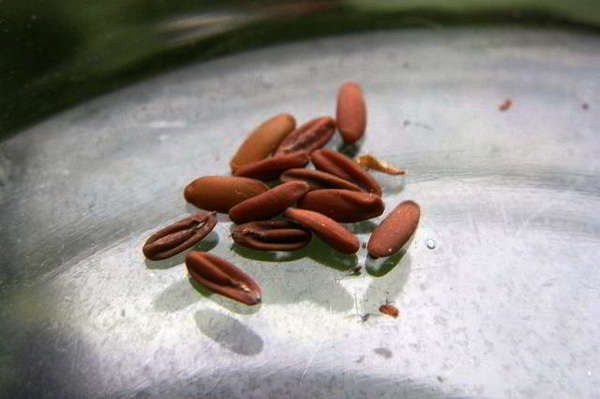

Soil (composition, characteristics)
Pelargonium is not demanding on the ground, it is suitable for the usual mixture bought in the store. But if there is a desire, then the soil can be prepared independently, then for this you need two parts of turf, one part of sand and one part of peat.
Sowing containers
For cultivation, boxes or pots are used. The pot in which the flower will be located is selected according to the size of the root system. The transplant is carried out only when the plant becomes cramped. It is advisable to use clay pots. They are highly breathable and absorb moisture.
Plastic pots can also be used, but they are breathable and can cause excess water to stagnate. This will entail root rot and death of the flower.
Optimal timing
There are no clear recommendations for when to plant pelargonium, since geranium from seeds is not particularly picky about growing. Florists advise to do this in the spring and summer season, when the greatest amount of sunshine.
If you don't want to wait for a warm time, it doesn't matter. You can use additional lighting of electric lamps and deal with seedlings all year round. Geranium will grow to medium size within 3-5 months.
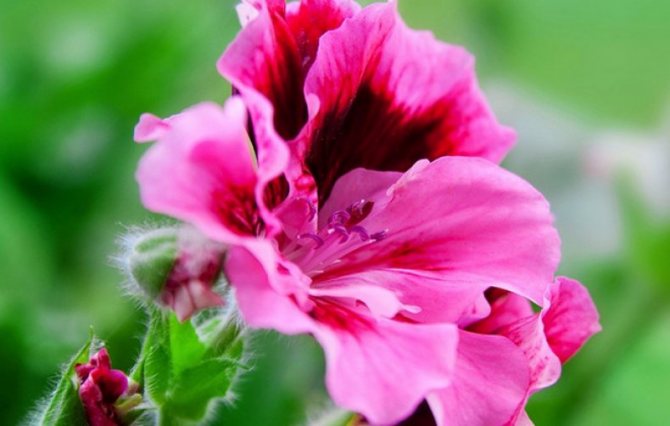

Seed sowing technology
Sowing takes place from the beginning of winter to mid-spring. The soil should not be dense and have an acidity of 6 pH.
The seeds are at an equal distance from each other, located in pre-prepared grooves. After sprinkled with earth. Watered and covered with cling film. Seed boxes are placed in a warm room, where the temperature is kept in the region of 22-24 degrees.
Watering is necessary as the soil dries up. When the first shoots appear, they need to be provided with good lighting, and the film can be removed from the box and the temperature reduced to 20 degrees.
Sowing seeds in peat tablets
You will need medium-sized tablets. They are laid out in a deep container and soaked in warm water so that they increase in size by about 6 times. Grain is placed in a special depression and slightly covered with peat from a tablet. Then the container is closed with foil or glass and placed in a warm place. The first shoots will appear after a week and a half.
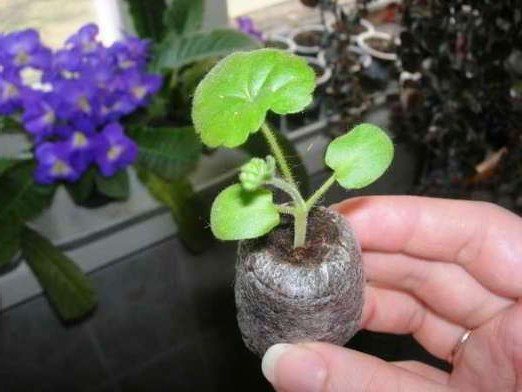

Take advantage of the helpful video about growing pelargonium seeds in hot peat tablets.
Features of the
What do they look like?
ATTENTION: Pelargonium seeds are similar in shape and structure to coffee beans. One side of the seeds is convex, the other is flat with a pronounced dividing line of cotyledons. Pelargonium seeds are usually deep brown in color. On the plant, the seeds are in the seed pod.
The ripe seed pod is brown in color. The seeds themselves are surrounded by a dense shell with a small umbrella of fluff. When the basket with seeds is ripe, it bursts, and fruits are formed in its place.
What does it take to appear?
When flowers appear on indoor plants, you need to take care of the seeds. Artificial pollination can be carried out. This requires the use of a pollen transfer needle or tweezers. In the center of the flower there are ten stamens and a pistil with a stigma. With the sharp side of the needle, carefully remove the pollen from one flower and transfer it to the stigma of the pistil from another flower. Its flower should bloom a couple of days before this procedure. Pollination in this way is possible many times.
How do seeds ripen and when to harvest them?
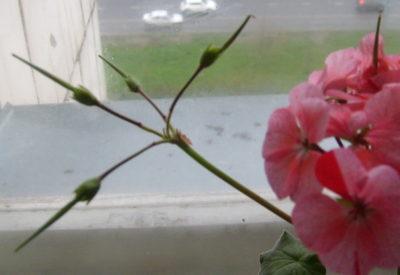

If pollination has occurred, after 3-4 days the column begins to slowly grow and lengthen. An elongated and pointed fruit-box is formed. Ripening, the capsule greatly increases in length and thickness. When the seeds are ripe, the fruit bursts... Oblong brown seeds, covered with long white villi, hang on thin elastic threads.
How to collect seeds at home? Seeds should be harvested immediately after ripening. It is advisable to collect seeds already from dry cracked bolls, this indicates that they are ripe. You should not wait for the moment when the box opens and the seeds fall off. They may start to sprout, making it difficult to store them.
Seedling care
Pots with seedlings are located on a sunny windowsill. But they should be protected from direct sunlight, so as not to burn the delicate leaves. After a couple of weeks, the first feeding is carried out. You can use liquid fertilizers with a lower concentration of nutrients.
Picking
Seedlings are transplanted only when four full leaves appear on them, without disturbing the earthen coma. Long-acting fertilizer is used before the pick. If geranium was grown in peat tablets, then after hardening, it is sent to the open ground.
Hardening
Occurs immediately before the resettlement of geraniums into open ground. Seedlings are initially placed on a cool windowsill, but that the temperature is not lower than 18 degrees. After a short while, you can open a window or window, while not creating drafts. When the night frosts are over, the seedlings can be transferred to a flower bed.
When to pinch seedlings
To carry out the pinching, the tip is removed. This is done to increase the branchiness of the flower. The procedure takes place from February to March. Pinching of the cutting is carried out over 8-10 leaves, and when pelargonium was grown from seeds - 6-8. The process is carried out according to the following rules:
- To avoid infection, pinching is carried out only with clean hands and treated instruments.
- After the procedure, in order to avoid stretching the shoots, the seedlings need a lot of sunlight.
- It is necessary to remove branches that grow towards the center of the pot. This will avoid flower diseases. For processing sections, you can use brilliant green, charcoal or alcohol.


Varieties and varieties
This group is rich in a variety of colors of buds, their shape and the number of petals. Pelargonium classification consists of several groups. A separate group was formed by royal pelargonium, ivy-leaved (ivy-leaved hybrid group), fragrant geranium, ampelous, angel and unique were allocated to a separate group. The largest group of pelargoniums is zonal, it is divided into terry (these include the actual terry varieties), semi-double varieties, rosaceous (rosebads) and tulip-like.
Non-double zoned pelargoniums include:
- miniature varieties;
- dwarf varieties;
- variegated;
- star-shaped;
- cactus.
Star-shaped
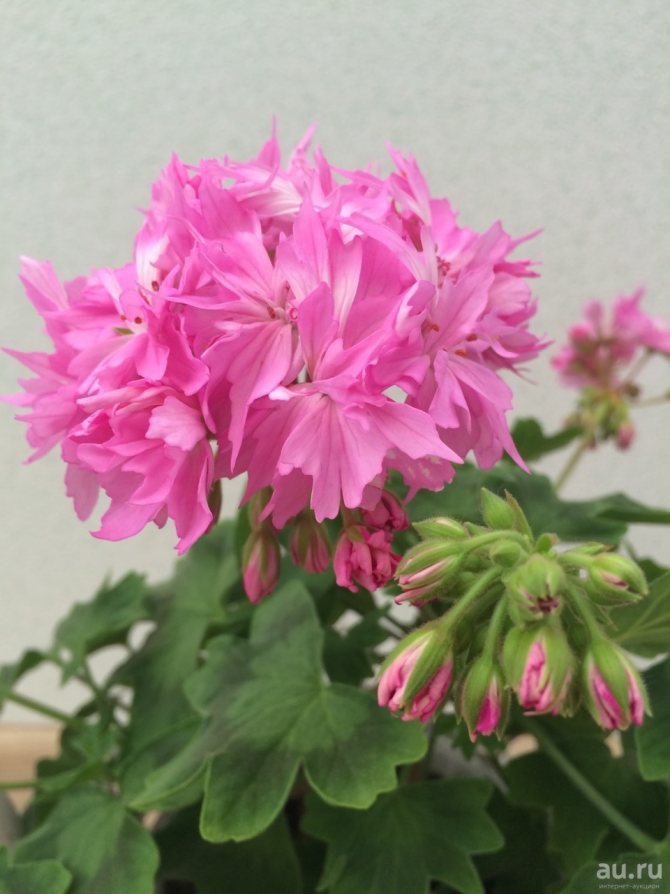

It has a very unusual and unusual shape for geraniums. The leaves and petals of the buds are deeply dissected, acquiring the so-called "star" shape. The petals are thin and curved, the upper two petals are longer.The variety is not terry.
Breeders bred this variety relatively recently - in Australia in 1950.
Now such varieties are popular as:
- Peppermint Star (with pale petals towards the center, and at the tips they are crimson);
- Star Flair (with bright crimson petals with a clearly defined white spot at the base of the petal, the petals are lanceolate);
- Swiss Star (two-tone petals of a delicate lilac color with bright coral stripes).
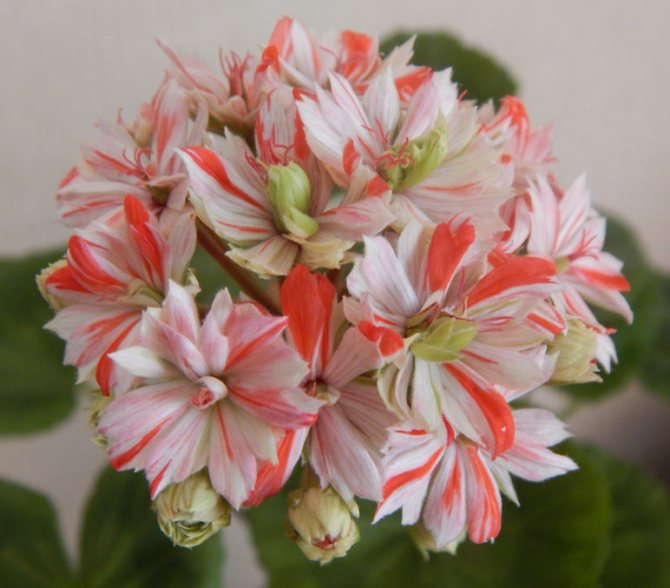

Swiss Star
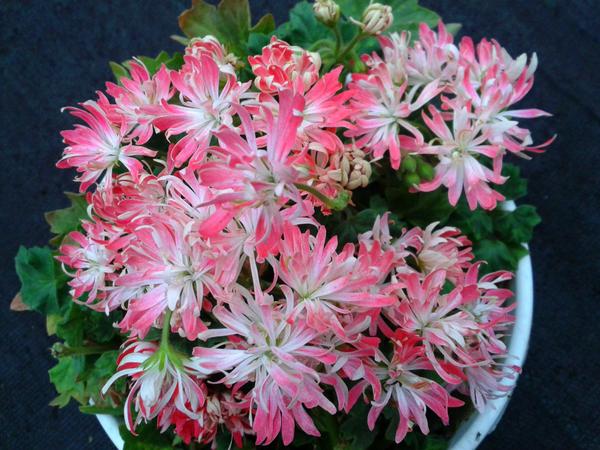

Star flair
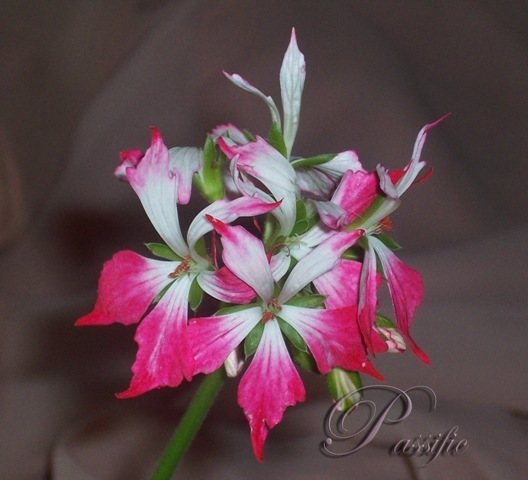

Peppermint star
Cactus


It is almost impossible to find such pelargonium on our windowsills - it is a very rare variety. The petals in the bud are twisted into tubes and intricately curved. Forms inflorescences of disheveled flowers that resemble cactus dahlias. The leaves are deeply dissected, green in color. These varieties were bred at the end of the 19th century, but, unfortunately, most varieties have already been lost.
Non-double or plain


The most popular and resistant varieties are not terry. They grew on almost every window sill and proved to be excellent. The color scheme is very diverse, the petals are rounded, 5 pieces in each flower. There are varieties with simple flowers, but very decorative leaves. The veins on the leaf plates are highlighted in a lighter color and form a reticulated pattern.
Semi-double


There are many semi-double varieties. They were singled out by the number of petals in a separate group. Each bud has 6 to 8 petals. The color of the petals is varied - from white to burgundy, and even almost black varieties.
Terry


Terry pelargoniums form lush inflorescences, opening up to form a ball. Each such flower has 8 or more petals. The petals are painted in different colors, the edge of the petal is wavy or serrated. The color is uniform and with a smooth transition from light to dark.
Rosaceae


A very old group of pelargoniums, which appeared in England in 1876. The petals in the bud, when opened, form a rose-like shape. The flowers are sterile, which makes it difficult to obtain new varieties. Recently, a dwarf variety has been bred, with red, pearlescent flowers, and beautiful mesh leaves.
Carnation
This group is very similar during flowering to carnations. The edges of the petals are serrated like those of carnations, and the buds themselves are much larger than those of ordinary pelargoniums.
The most common varieties:
- Pat Hannam (petals are pale pink and deep lilac);
- Graffiti Violet (has lilac-purple flowers);
- Freshwater (petals are pale pink).


Freshwater
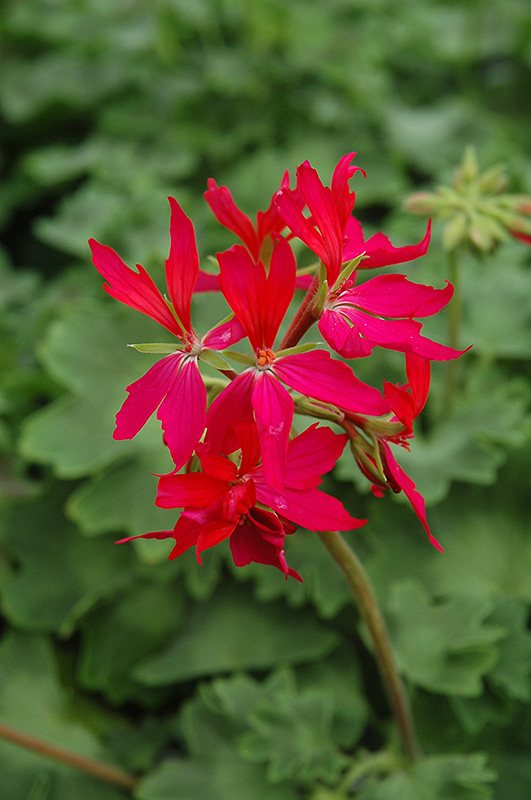

Graffiti violet


Pat hannam
Tulip


Pelargonium got its name for the shape of the buds. They are never fully revealed. But the shape may differ - in some varieties it is pointed conical, while in others it is round, resembling the shape of a barrel. There are simple and double varieties of tulip pelargonium, as well as varieties with a double edge.
The color of the petals is varied, but the outer side is colored a little lighter. One inflorescence has 20 to 40 buds. In height, some varieties reach 80 centimeters, but there are also dwarf ones no more than 30 centimeters. If the flower is completely opened, it should be removed immediately, if this is repeated again, then the whole plant is cut off at the root.
Deacon


This variety was obtained by crossing the Orion Zoned Miniature Pelargonium and the Blue Peter Ivy Pelargonium. The new variety was shown in 1970 in Chelsea. Breeder S. Stringer got a very compact bush with abundant flowering. Varieties of orange, red and pink shades were bred.
Rafaella


Low variety - up to 30 centimeters, with beautiful large inflorescences. The inflorescence cap, consisting of semi-double flowers, can reach 12 centimeters in diameter. This is a new variety with excellent characteristics. Able to withstand heat and short-term cold snap.It can be grown at home, on a balcony in containers, or planted outdoors.
With proper care and adequate lighting, flowering can last all year long. The first shoots will appear within five days after planting, and flowering begins in early May, even in the youngest plants. The inflorescences are painted in different colors - there are white, pink, scarlet and crimson varieties.
Yitka


Pelargonium zonal Yitka is a beautiful low bush. The plant grows in height up to 30 centimeters, and in width up to 25. During flowering, the whole plant is covered with lush caps of salmon-colored flowers. The plant is very hardy, easily tolerates heat, but a western or eastern window is suitable for growing at home. It is necessary to ensure a decrease in the temperature regime in winter to 10-12 degrees.
Royal Pelargonium from seed
Unlike other varieties, it grows in South America. She is very moody and requires maximum attention. Loves humid air, lack of direct sunlight and drafts.
Planting begins with the onset of the winter months. For the royal, a light soil is needed, which is constantly kept moist. The room temperature should not drop below 20 degrees.
The first shoots appear after 21 days. After that, boxes with seedlings are moved to a room with a temperature of at least 15 degrees. When three full-fledged leaves appear, the sprouts dive into different containers.
Royal Pelargonium has several types: Ansbrock Beauty, Charmi Elekto, Deerwood Angel Eyes, Fairy Queen, Tip Top Duet, Deerwood New Day.
Step by step instructions: how to grow at home?
What is the time to sow?
When to sow? Sowing pelargonium at home can be done all year round, but only if additional lighting is provided. The most favorable time for sowing seeds is February or March... If you sow pelargonium later, the plant stretches strongly and blooms only after 9 months (why does not pelargonium bloom?).
Soil preparation
IMPORTANT: Pelargonium prefers light, nutritious soil that allows water and air to flow well to the roots of the plant. To germinate seeds, you can use ready-made storey soil or make it yourself.
There are several options:
- mix in equal proportions peat, sand, humus and compost;
- combine two parts of garden land with one part of peat and sand;
- dilute peat with perlite in a 1: 1 ratio.
Before sowing seeds, the prepared substrate must be disinfected.to avoid further infestation with pelargonium. To do this, it is calcined for several minutes in the oven.
For soil treatment, you can use high quality ready-made fungicides or manganese. Then the landing should be postponed for one day.
Selection
To grow pelargonium quickly and without problems, you need to select and prepare planting material. When selecting seeds, special attention should be paid to the following signs:


Color... Quality pelargonium seeds have a pronounced brown color. Slight dullness and light shade are allowed.- The form... The developed seeds are oblong, small depressions are visible on the sides.
- The size... The planting material is large enough.
- Shell... Pelargonium seeds are characterized by a dense leathery shell.
If the planting material has all these qualities, then it can be purchased. You should not choose seeds that have the following characteristics:
- small;
- flattened;
- deformed;
- covered with spots of different colors.
The seeds of some types of pelargonium, especially ivy, do not sprout for 2-3 months. It is necessary to remember this and not stop caring for the crops.
To maximize the shortening of germination time, a scarification procedure is carried out... It consists in removing part of the seed coat to provide access to nutrients. This requires:
- Use a fine to medium grit sandpaper. It will help remove the surface layer without traumatic tears.
- Slowly rub the seed 2-3 times on the sandpaper with rotating movements.
Features of growing from seeds of ampelous pelargonium
Native to South Africa. Capricious enough, but with careful care, it will give you a luxurious color. Popular in horticulture and used for hanging flower beds, outdoor areas, verandas. Its shoots reach almost one meter in length.
Ampelnaya fruits are placed in soil, previously moistened with water. After that, the box with future sprouts is covered with cling film and sent to a warm room.
Attention! This species is quite capricious in seed reproduction. Even experienced growers prefer cuttings.
Planting instructions
The soil is considered ideal for planting pelargonium, which includes 2 parts of river sand and peat and two parts of sod land. You can buy ready-made soil specifically for pelargonium. It is not recommended to add fertilizers - the flower does not like this. The most suitable containers are peat or plastic cups.
Instructions step by step:
- The cups are filled with earth.
- Then she is poured with warm water.
- Seeds are placed in 2-3 pieces. into each container.
- They can be sprinkled with soil 1 cm or slightly pressed into the soil.
- Cover with cling film, not forgetting the holes.
Seeds begin to germinate at 20–22 ° C after 2–3 weeks. In rare cases, a month passes before the first shoots appear.
Pelargonium ivy growing by seeds
A feature of this variety is the flexibility of its stems, which allows it to curl. The shoots reach one meter in length and the molding has a smooth texture. Ideal for hanging gardens, balconies, verandas.
Reproduction using seeds is as follows:
- The grains are placed in a box with loose earth to a depth of half a centimeter.
- The tray is placed in a greenhouse or covered with foil and sent to a warm room.
- It should be kept at a temperature of 22-24 degrees Celsius, with good lighting.
Before emergence, it is necessary to monitor the moisture content of the earth. After three weeks, the sprouts are planted in different pots. When they are strong enough, you can start feeding them with mineral fertilizers.
Attention! It begins to be sown from the beginning of winter to mid-spring. In winter, the use of a phytolamp is a mandatory requirement.
Description of the plant and its features


Zonal pelargonium is an erect shrub. In the process of growth, its trunk at the base becomes lignified and covered with a coarse brown crust. The plant can reach a height of a meter, but there are also miniature varieties. The whole plant is covered with soft villi, and the edge of the leaf blade has a dark green, yellow or brown edging, it is this color that gave the name to the pelargonium group. The leaves are round, with soft, shallow dissections and smooth serrations along the edge.
The leaves are arranged alternately, attached to the trunk with a long handle. Beautiful flowers are collected in globular inflorescences and always rise above the total mass of greenery on long peduncles. Plain or double flowers come in a variety of colors. There are white, pink, red petals of various shades. There are varieties with a two-tone color or with veins and strokes on the petals.
Breeders have even bred the blue color, which is not typical for pelargonium, in the Blue Blood variety.
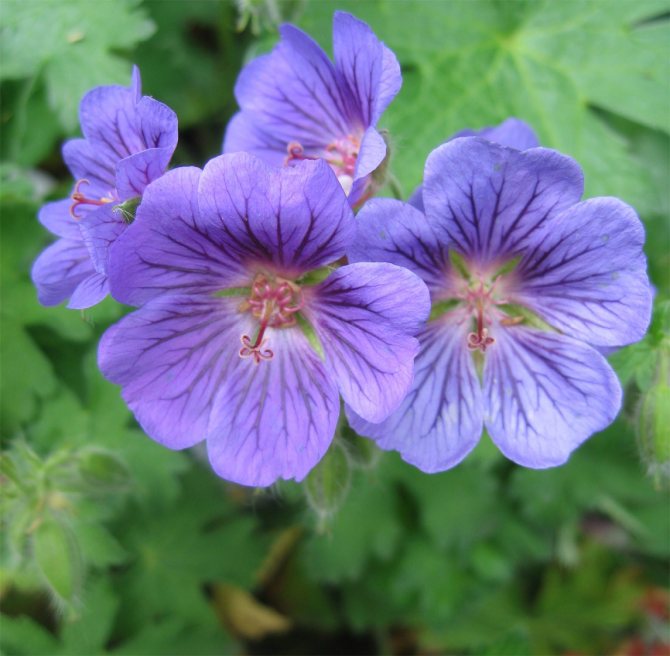

Geranium variety Blue Blood
The gradual opening of the buds in the umbrella and the constant formation of new inflorescences in the leaf axil allows you to maximize flowering from early spring to late autumn, and sometimes to mid-winter. But not only because of the buds, these flowers are grown - the leaves of some varieties are very decorative and, in addition to their unusual color, have a wavy edge.
Observing some conditions, the flower will delight more than one year. True, within 2 - 3 years the plant will stretch out and lose the lower leaves, exposing the trunk, but in this case, strong pruning will help to rejuvenate the bush.
When and how to plant seedlings in the ground
Seedlings are sent to the garden only after hardening. The main thing is to make sure that there is no frost at night.
Important! Not all types of pelargonium are suitable for gardening. For example, the royal does not like drafts and is intended only for home keeping.
The soil should be loose, well-drained, and free of clay. Geraniums should be avoided in direct sunlight, so it is best to place the flower bed in partial shade. Flowers are planted in a flower bed at a distance of 30 centimeters from each other. Watering should be moderate, but drying out should not be allowed. It is necessary to remove faded buds in a timely manner.
Choosing a place for planting, soil
The place in the flowerbed should be of medium fertility, loose and well-drained. Pelargonium does not tolerate stagnant water, therefore clay soil is contraindicated for it. The area where geraniums will bloom should be shaded to avoid burns from direct sunlight.
Further transplant
The signal that the time has come to transplant seedlings into pots will be the appearance of 2-3 leaves on the seedlings. It is at this age that the plants are ready for picking. You do not need to choose a pot that is too large for a flower; a container with a diameter of about 10 centimeters will be enough.
In the future, you may need another transplant into larger pots, but this is already over time. They recommend containers made of natural material, clay is good. This will help protect the plant from overheating and will retain moisture longer, which means pelargonium won't need to be watered frequently.
Plant care (watering, feeding, tying)
Geranium categorically does not tolerate organic fertilizers. It is enough to feed it, during the period of active growth, a couple of times a month. Top dressing is completely canceled during rest, that is, in winter.
The flower is tied up with a standard cultivation form. When the trunk is high enough, rounded pegs firmly stuck into the soil are used to tie it up. It tends to heat up moisture, therefore it is resistant to drying out. However, frequent watering is required in the summer. But oversaturation with water can lead to death, so you need to provide it with good drainage.
Attention! The plant does not like spraying. It can lead to the appearance of fungal diseases.
An overabundance of water is evidenced by drooping leaves. This is a sign of illness. And when the soil dries out, pelargonium stops blooming, yellowness appears.
Care
Favorable conditions for growing pelargonium from seeds:
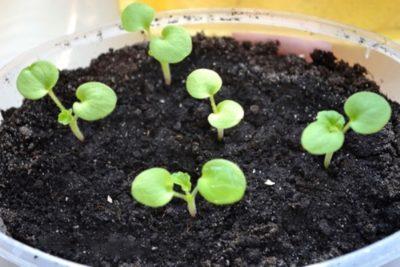

Temperature... It should be within + 18 + 24 ° C. Otherwise, the seedlings will not germinate.- Humidity... The high moisture level accelerates the seed germination process. Grains and seedlings must be kept in a greenhouse until the first pair of true leaves appears. It is ventilated 2 times a day.
- Backlight... When sprouts appear, the greenhouse is exposed to bright, diffused light. The length of daylight hours is at least 12 hours. You can use a fluorescent lamp for artificial illumination. Without light, pelargonium seedlings stretch out.
Pelargonium seeds sprout within 2-14 days from the moment of planting. Terry varieties with germination can stay up to 1 month.
In order for the plants to form a beautiful bush, they need to be properly cared for. Pelargonium needs timely watering, top dressing, loosening of the soil, warm climate, picking and pinching.
More details about caring for pelargonium at home can be found here.
Possible growing problems
Difficulty flowering, leaves, buds or growth may occur during breeding. Fortunately, most troubles can be easily resolved.
Issues with sheets
With improper care, the following symptoms may occur:
- yellow edging of the lower leaves - insufficient amount of feeding;
- red-red color - indicates a lack of magnesium, or cold nights;
- deformation of the form - pincers;
- distorted foliage, yellow or white spots - the presence of aphids;
- yellow weakened leaves - means the presence of a whitefly, root rot
- systems, bacterial disease;
- decay of the trunk, wilting, the appearance of spots - stem rot, spotting;
- white mold, blackening and dying off - the presence of powdery mildew.
To avoid problems, you need to be careful about the health of the flower. Keep in a warm place, make regular feeding and carry out prophylaxis against parasites and diseases.
The lack of flowers and buds is extremely rare. This is most often due to over-watering, sultry weather, or lack of sunlight.
Growth problems are usually accompanied by the following symptoms:
- poor growth - parasite infestation, unsuitable soil acidity;
- spindle-shaped growth - lack of sunlight;
- the appearance of yellow foliage, poor growth - indicates a lack of nitrogen;
- leggy - lack of pinching, excessive feeding and watering;
- wilting between waterings - indicates the small size of the pot.
Photo
Check out the photo of pelargonium, which even a novice florist can grow, following our recommendations step by step:
Diseases and pests (treatment)
With improper care, novice gardeners can meet with plant diseases, which can lead to the death of the flower. Types of diseases and how to deal with them.
Gray rot. Lack of color, yellowing of leaves, the appearance of brown spots located closest to the soil means the presence of this disease. Causes of occurrence:
- high humidity;
- lack of ventilation of the room;
- spraying;
- increased nitrogen content in the soil.
In the fight against gray mold, systemic fungicides will help. When using them, the dosage is strictly observed.
Alternaria. The disease is characterized by the appearance of dark spots with a light core. With high humidity, a velvety coating is possible.
To prevent disease, it is worth providing proper care. Regular ventilation, moderate watering and loose soil are all that geraniums love. Alternaria is treated with systemic fungicides with a long-term therapeutic effect.
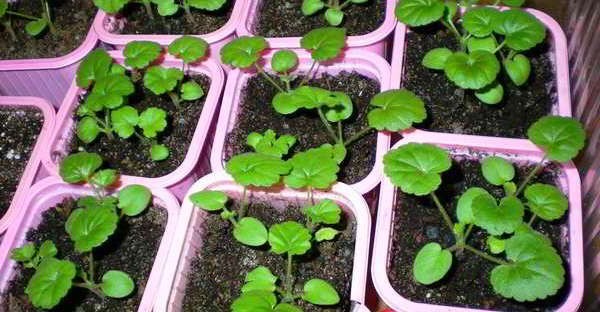

Rhizoctonic rot. It is characterized by a depressed leaf or stem structure. At the same time, the plant has a lack of color, yellowing and wilting. Causes of occurrence:
- excessive moisture;
- lack of light
- lack of ventilation;
- high room temperature (usually associated with the contact of heating devices);
- excessive use of fertilizers.
In the fight against the disease, again, a specially designed tool designed to protect against rot will help.
Late blight. The disease is associated with high air temperature, excessive moisture, high fertilizer content, and overly dense plantings. It is accompanied by the following symptoms:
- cessation of flowering;
- fades. dries;
- decay appears;
- depressed spotting is noted on the roots;
- the spots gradually rise.
Attention! The pathogen remains in the ground for many years. The number can go up to 10-15 years.
Rust. Occurs in high humidity and excessive heat. It is transmitted from plant to plant by air and water. Accompanied by the following signs:
- lack of flowering;
- the appearance of yellow spots on the top of the sheet;
- pustules form on the back;
- with a progressive disease, the leaves turn yellow, dry and fly around.
To fight the disease, the room temperature and humidity levels are reduced. All affected areas are removed and treated with a special agent.
Verticillary wilting. The disease leads to yellowing of the edges of the lower leaves. Over time, they darken and fade. If you do not fight the disease, then it is transferred to the healthy part.Vertical wilt affects those plants that are grown in one place for a long time. Most often, infection occurs in the summer.
To avoid the spread of the disease, it is required to water the flower in a timely manner and remove the remnants of the diseased plant. The cuttings should be rooted in clean soil. For treatment, fungicides with a long-term therapeutic effect are used. Also, the incorrect content of geraniums leads to the appearance of harmful insects.
Multi-claw mites. When it appears, the growth of leaves at the top of the shoots stops, and the back side is covered with a gray-brown scab. Excessive heat and high humidity provoke the emergence of these insects. For mild lesions, soap or mineral oil can be used. And you can also resort to treatment with chemical protection agents.
The larvae of mushroom gnats. Most often, the larvae infect cuttings and seedlings. They stop growing and die from rotting at the base. Parasites appear from excessive moisture. In order to prevent the appearance of pests, seedlings and cuttings are treated with systemic insecticides.
Thrips. The leaves of the flower are deformed, the growth point is bent, growths form on the back. The inflorescences are covered with spots, a gray-brown edging appears on the petals.
They fight thrips in several stages. Sticky blue traps are placed next to the young. After that, the seedlings are treated with insecticides. Re-spraying is carried out after about 5 days.
Aphid. Signs of appearance:
- curliness;
- yellowing;
- with a strong lesion, aphid secretions are visible.
Small clusters of aphids are cut off along with the affected areas, or washed off with soap and water. In case of severe damage, use chemicals.
Caterpillars. Leaves become nibbled, caterpillar waste is visible. The method of struggle is very simple - in isolated cases, they are collected by hand in the evening. Or they are treated with special preparations.
Whitefly. Clusters of insects are visible. When a plant is severely damaged, its leaves turn yellow. They fight with yellow adhesive tapes, as well as preparations with potash oil or whitefly insecticides.
Spider mite. They feed on cell sap, which leads to the appearance of small transparent holes, and then yellowing and wilting of the plant. Appear at an elevated room temperature and excessive dryness.
You can fight the tick by treating the plant with soap or mineral oil. But this method is suitable for a mild form of pest damage. In other cases, insecticides are used.
Pelargonium zonal - description and features
Now geraniums are actively selected using the latest biotechnological methods - large horticultural centers are engaged in this. Increasingly, hybrid seeds (labeled F1) appear on the shelves. By the way, Germany has made the greatest contribution to the development of different varieties.
One of the most popular types of pelargonium among flower growers is zonal pelargonium. It is she who has the greatest varietal diversity - there are more than 75 thousand of them. Pelargonium zonal got this name because its leaves are colored with a color different from the main background, and the petals of double or simple flowers are often painted in two colors. The leaf area usually looks like a spot of color or a ring in the center of the plate.
Attention! If there is little light, then the area colored with a different color may disappear. For example, in winter, the leaves of zonal pelargonium often have a monochromatic color, but in the spring the colored area appears again.
Zonal pelargonium is a lush erect perennial bush rich in leaves, the flowers of which are collected in rich inflorescences. The leaves have a specific geranium aroma and light edging. Such geraniums entered floriculture from about 1710, having arrived in Europe from the African Cape, and previously had a very high stem.But in the process of selection (from about 1844) that neat pelargonium appeared that is growing on window sills now.
By the way, with proper care, pelargonium can bloom throughout the summer. And if you take good care of her in winter, then the whole year. The plant feels great both at home and on the street, in the garden.
On a note! A small addition regarding the color zone on the leaves: in some plants, the pattern may be bright, while in others it may be completely absent. But at the same time, zonal pelargonium still remains zonal. This property makes it possible to successfully apply geraniums in landscape design.
Now there are two main areas of work of breeders with geraniums - the appearance of plants with star-shaped flowers and geraniums with a beautiful pattern on the leaves. The former look very beautiful, attract the attention of flower growers with the openwork shapes of the inflorescences, the latter have a border of leaves of different shades (yellow, white). Earlier, even in such plants, flowers were specially cut off so as not to hide the beauty of the leaves under them.
Flower care during and after flowering
During flowering, regular but moderate watering is required. It is advisable to loosen the ground around the flower regularly for good oxygen circulation. For good flowering, it must be provided with constant sunlight. You need to feed it twice a month.
After flowering, in the winter season, watering is minimized, and fertilization is postponed until spring. It is desirable to provide backlighting. The room should not be very hot, it is necessary to protect geraniums from contact with heating devices.
Watering correctly
Improper watering can cause disease and even death of young plants.
Helpful hints:
- Do not over-moisten the soil... This leads to blackleg, a disease that develops rapidly and destroys the seedlings. To avoid this, it is imperative to make a drainage layer and holes for the drainage of excess water in the containers for planting.
- It is required to observe the watering regime... Seedlings are watered as the soil dries up, being careful not to flood them. After picking in separate containers, the plants are watered no more than twice a week. In winter, the frequency of watering is reduced to once every seven days.
The first time they feed pelargonium two weeks after the pick. For this, fertilizers are used for flowering plants with a rich content of potassium and phosphorus. The frequency of dressing is once every two weeks. In winter, feeding is stopped. You can find out more about how to feed pelargonium here.
Watch a video about watering and feeding pelargonium seedlings from seeds:
Forum, reviews of florists
After talking with experienced gardeners on the forums, you can find out how to grow geraniums from seeds if the usual planting did not work. To do this, the seeds are soaked in a growth stimulator, then they are put into a cotton pad or a small piece of cotton wool and, after they hatch, they are planted in the ground.
On other forums, you can find information that it is absolutely not necessary to soak the seeds, but it is worth covering the box with a film, placing it on the sunniest windowsill. And the film is removed only after germination. However, some growers do not recommend creating a greenhouse, as this is fraught with a black leg in the seedlings.
That's all the recommendations that I wanted to give on the topic: pelargonium from seeds at home. This is a kind of plant. Not demanding, but you cannot do without certain rules of care. If all instructions are followed, the apartment or house will be decorated with beautiful and unique flowers.
Requirements for planting material
Geranium propagation at home occurs by seeds. The main criterion for seeds is their quality. They should be brown, oblong and hard. You should not buy planting material in the market or in other unverified places; it is better to do this in a specialized agricultural goods store. Let it turn out a little more expensive, but more reliable.Then you will be sure that you will grow the geranium of the right color, durable and beautiful. Good seeds are sold ready for sowing, so you don't have to make much effort to plant.
Subtleties of lighting and temperature
In no case should there be a lack of light for this beauty. Otherwise, it will leave you without flowers and will delight you with a half-empty stem with small leaves. To get the opportunity to observe the chic hat and fragrant flowers, you need to pick up the pot in the brightest place, for example, the south side of the house. But, if, after some time in the sun, faded yellow spots began to appear on the leaves, then you must definitely add shadows. In winter, small lamps are suitable for good lighting.
The heat is harmful for a little beauty. She will not stand the 30-degree heat. The standard for pelargonium zonal F1 is stable +20 degrees, maximum +25. Drafts and cold glass are also enemies for the plant.


What diseases is it susceptible to?
Due to non-observance of the correct conditions, the cultivation of pelargonium can get sick. Consider the main reasons for the plant's poor health:
- Due to waterlogged soil... Root rot when the base of the stem has darkened. Gray rot (mold on the leaves). The leaves are lethargic and fall off. Swelling (water pads on the leaves).
- From insufficient watering... Leaves turn yellow and fall off. Only the edges of the green leaves dry out.
- From lack of light... Leaves fall off (even green). The stems are bare.
- From excessively warm indoor air... No flowering, although the plant looks healthy.
- From low temperature... Reddening of the edge of the leaves.
Pelargonium definitely dies only if it is affected by root rot, while it is better to destroy the plant. The cause of gray rot is not only over-watering, but also in infection with the fungus Botrytis, then the plant should be treated with a fungicide. In other cases, it is enough to remove the damaged parts and exclude the cause of the disease.
Features and conditions for growth
In order to know how to grow lush pelargonium with bright flowers, it is enough to carry out simple care for it.
Soil selection
For good growth, abundant flowering of pelargonium, a well-drained soil is needed, including compost, peat, humus and sand.
Proper watering
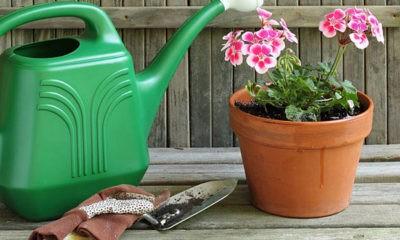

Low humidity is essential for a healthy root system. Pelargonium, like geranium, it is better not to water than to pour... If the plant is in a waterlogged substrate for a long time, it threatens with rotting of the root system.
In summer and winter, a different watering regime is needed. But always the best sign of the need for the next soil moisture is its dry state. No need to spray the leaves.
Good lighting
Pelargonium is a light-loving plant, therefore it blooms well on sunny windowsills... If in the summer she is in the garden, then she must choose a place, sheltered from the wind and sunny, although she grows well in partial shade. If the lighting is insufficient, the stem may be exposed.
Temperature regime
For normal growth and flowering, the temperature of pelargonium is needed at least 10-12 degrees Celsius, the optimal one is up to 20 degrees.
Pruning
Pruning is possible in both autumn and spring... But if necessary (for example, when the branches are bare), you can prune at any time.
Pruning provides:
- Formation of a beautiful and compact crown.
- Overgrowth of lateral shoots and the appearance of inflorescence rudiments.
- Lush and abundant flowering.
- Own planting material.
TIP: To protect against decay, the cut area can be sprinkled with, for example, crushed charcoal.
Topping
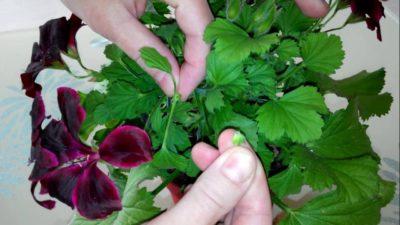

To form a lush bush, increasing the branching of the stems, you need to pinch the young shoots. This is usually done before spring or at the beginning of it, that is, in February-March. But when necessary - when required.
Pinching, pinching or pinching is the removal of the top from young seedlings in order to enhance the development of lateral shoots so that the plant does not stretch upwards, but a bush forms. During the pinching process, it is important not to damage the main plant.
Top dressing
To ensure a long and abundant flowering of pelargoniums, they must be fed with the necessary elements.... Feeding rules:
- During active growth, liquid mineral fertilizers with a minimum of nitrogen and a maximum of phosphorus are recommended. Before applying liquid fertilizer, the plant should be watered to avoid damage to the roots. in dry soil, fertilizer can burn them.
- In spring and summer, the need for feeding pelargonium is high, you can start it in early May and spend it until the end of September.
- Potassium contributes to a bright, abundant and long-lasting flowering.
- In hot weather, it is better not to carry out the procedure or transfer the plant to the shade.
IMPORTANT: Fertilizers for indoor plants can be purchased at flower shops and follow the instructions for them.
Types of homemade pelargonium with photos and names
Geranium zonale (Pelargonium zonale)
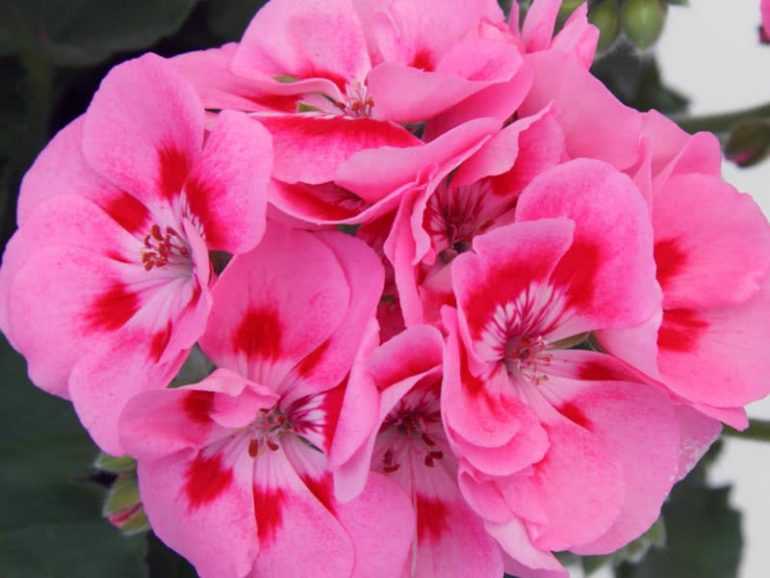

Perennial highly branched dwarf shrub, up to 90 cm tall. Rounded champlevé leaves have a dark circular border. Flowers 2-3 cm in diameter, shades from white to red, simple or double, collected in umbrella-shaped inflorescences-caps. Blooms from spring to autumn. In summer, it can be planted in open ground.
Royal Geranium (Pelargonium Regal)
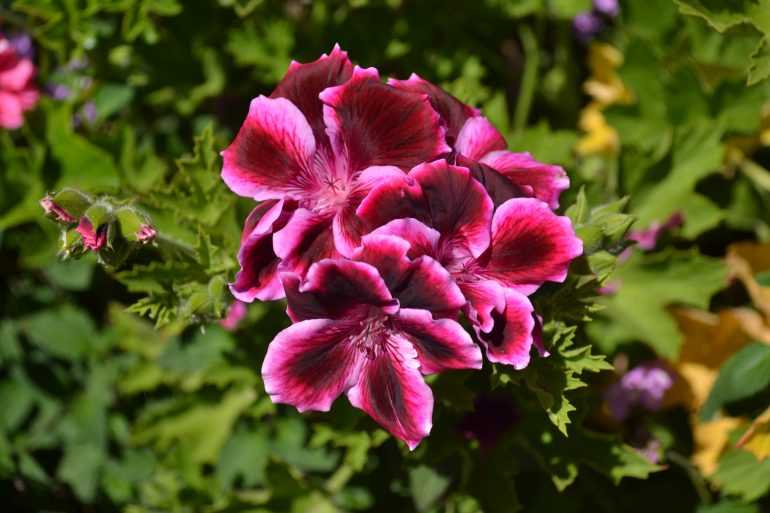

Other names are large-flowered hybrid pelargonium, English pelargonium. This species has a straight, slightly branched stem with sharp-bladed folded finely toothed leaves along the edges. The flowers are beautiful, large, up to 5 cm in diameter, simple and double, from white to red-purple. Grown only indoors.
Geranium ivy, or thyroid (Pelargonium peltatum)


Low shrub with drooping, slightly ribbed branches. Leaves are thyroid, glossy green, fleshy. Flowers of 5-8 pieces are collected in umbrellas. Blooms all summer. It is often used as an ampelous culture.
Top dressing
It is advisable to introduce top dressing with each watering, accordingly reducing the dosage. So, if watering is done every day, then we divide the weekly fertilizer rate by 7-10 and give this dose at each watering. If the lump has time to dry out between waterings, then you must first moisten it with clean water. During the winter rest, feeding is canceled if the temperature is kept low and the plants are completely resting. When there is even a small growth, fertilizers can be added in ¼ dosage. Soon after the cuttings have taken root, a fertilizer with a high nitrogen content is used. For feeding young plants that are not yet allowed to bloom, a complex universal fertilizer is used. Before the onset of the flowering period, approximately 2.5-3 months (in April), they begin to use a fertilizer with a higher potassium content. If there are signs of chlorosis, it should be treated with magnesium sulfate and iron chelate (or just a solution of trace elements in a chelated form).
|
Landing
Priming Pelargonium prefers fertile and well-drained. It consists of sod land, humus, peat and sand in approximately equal proportions.
Life span a separate pelargonium bush is usually 2-5 years, after which the plant loses its decorative effect and it is better to take care of the renewal in time by rooting cuttings. It will take about a year or more to grow an ornamental flowering plant from a cuttings. Cuttings rooted in early spring can bloom this summer, but it is advisable to give preference to the formation of a beautiful bush for abundant flowering next year.
Cuttings can be taken at any time, from early spring to autumn.But here it is necessary to take into account the time of the onset of flowering of the plant, which for different varieties ranges from 16 to 20 weeks after the last pinching or pruning (flowering occurs on young shoots that have reached this age). If you have a single copy of this variety, then to cut the cuttings you will have to wait until the end of flowering. If there are several specimens, then it is better to take cuttings earlier, starting from February-March, then the young plant will have more time to develop for lush flowering next year, until this moment it is necessary to remove all emerging buds. It is not recommended to take cuttings earlier than the end of January, with a short daylight hours. By this time, the plants are just beginning to wake up from the cool wintering. If you take cuttings from dormant plants, then the level of growth hormones in them is low and it will take more time for rooting. For such pelargoniums as angels, royal and fragrant, it is advisable to take cuttings in late winter or early spring (later, with an increase in the level of illumination, the laying of flower buds will already begin closer to the tops of the shoots). For most varieties of zonal pelargoniums, this period is not so important, since their flower buds are laid along the entire length of the shoot and cuttings can be taken at any time of the growing season.
Cuttings must be cut only from healthy and powerful plants - the stronger and chunky the cutting, the better it will develop in the future. For cuttings, take the apical parts of the shoots about 5-7 cm long, from miniature and dwarf varieties - about 2.5-3 cm. The lower leaves and stipules should be carefully removed, under the lower node, make an oblique cut with a slight slope. Dry the lower cut of the cutting in the air; depending on the conditions, this may take from several hours to several minutes. You can use drugs that stimulate root formation, but pelargonium gives roots well without their use.
|
It takes 2 to 4 weeks to root, depending on conditions and variety. The roots are formed on the lower cut of the cutting. A mixture of sterile peat substrate and perlite in approximately equal proportions is used as a soil for rooting. It is important that no water stagnates in the ground. Sterilizing the soil prior to use reduces the likelihood of cuttings rotting. Small pots (6 cm in diameter) or transparent cups (100-200 ml) are filled with the soil mixture and kept on a tray with water until the upper part of the substrate is wetted. After that, the soil is allowed to dry for about a day.
Another way of rooting is also popular. Two pots are taken, a second, narrower pot is inserted into a wider one, the space between them is filled with soil, prepared cuttings are planted here. They are immersed in the ground by about 1-3 cm (depending on the variety) and pressed lightly.
The next watering is carried out sparsely and through the pallet when the soil dries up. It is advisable, after planting the cuttings, to introduce a systemic fungicide into the soil during the second watering. A greenhouse for rooting pelargonium cuttings is not required. For the first 2-3 days, the leaves may wither (do not put the cuttings in sunlight!), Later they restore turgor.
The optimum rooting temperature for pelargonium cuttings is about + 20 + 22 ° C.
After rooting, the first pinch the cutting is carried out when it forms 8-10 leaves. The apical growth point is removed with a sharp sterile knife. This stimulates the growth of lateral shoots from the axils of the remaining leaves. If shoots begin to grow only from 1-2 upper buds, then it is advisable to remove them or pinch them as soon as they give 3 leaves. The next pinching is carried out as the side shoots grow, when they form 8-10 leaves. This will ensure lush branching, and subsequently abundant flowering. It is optimal to form a crown in the form of 2/3 of a ball. The last pinching of the plant is carried out no later than 16-20 weeks (depending on the variety) before the expected flowering.Since the flowering is also influenced by external factors (illumination), it can be expected to start in May or June, so the last pinching is carried out no later than February. As it grows, diseased or weak shoots are removed, too rapidly growing are shortened, trying to maintain the uniformity of the roots. Also, cut out all leaves that do not match the grade in size or color.
As a young plant grows, it several times per season transplanted (neat transfer) into a slightly larger pot, not trying to give a large volume at once. Transshipment is carried out only when the roots are tightly entwined with a lump. For a one-year-old plant, the maximum pot size should not exceed: for miniature varieties - 9 cm, dwarf varieties and angels - 11 cm, for other varieties - no more than 15 cm in diameter. The last transplantation of cuttings rooted in this season is carried out closer to the winter rest or after its end at the beginning of the next season.
Major pests
The main pests of pelargonium are aphids and whiteflies.... Aphids are green, gray or black insects. The whitefly looks like a small white butterfly. Both pests are usually found on the underside of the leaves. Special insecticidal preparations, which can be bought in flower shops, help to fight them.
You can learn more about the diseases and pests of pelargonium here.
Pelargonium deserves to decorate any home with its bright and lush bloom. Previously, it was even considered an aristocratic plant, and in Europe and the United States, pelargonium has been grown for more than one century.
If you find an error, please select a piece of text and press Ctrl + Enter.
Popular varieties of zonal pelargonium
Most often, in home collections, you can find several varieties of zonal pelargoniums, which delight with beautiful flowering and unpretentiousness:
- Apple Blossom Rosebud. Rosebud variety, double flowers, white tone, with a pinkish border and a green center. Leaves are simple, green;
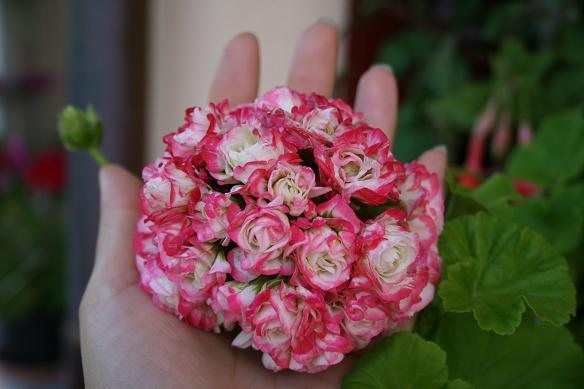

Pelargonium zoned Apple Blossom Rosebud
- Red Pandora. Tulip-shaped pelargonium, flowers of a complex color - deep pink-red inside, outside - light red, with veins;
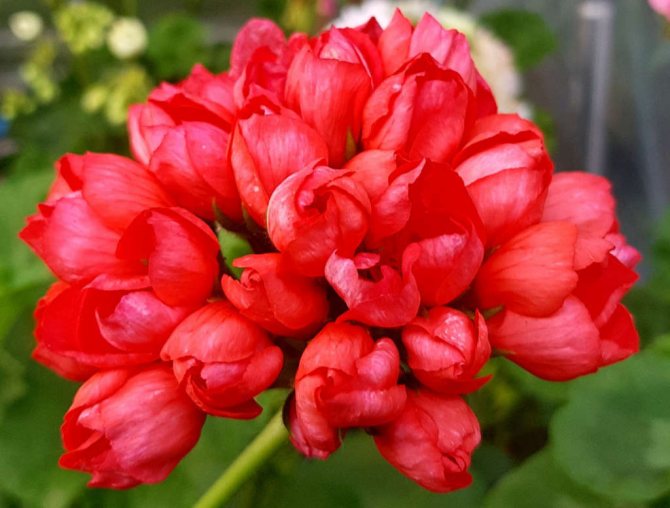

Pelargonium Zone Red Pandora
- Rumba Fire. Medium-sized variety with red, almost glowing inflorescences;
- Bravo Pastel. The color of the petals looks rather unusual - a crimson-pink center stands out against a white, almost salmon background;


Pelargonium zonal Bravo Pastel
- Meteor. Bright red flowers with dark longitudinal stripes look spectacular against a background of dark green foliage. A low-growing variety, has proven itself well in garden cultivation.
The varieties "Merkur 2000", "Alba" and "Sharman 98" have long become a kind of classics and are loved by flower growers.
Agricultural rules
Watering
Since zonal pelargonium belongs to drought-resistant crops, only young specimens need regular watering when they are planted outside (until they begin to grow intensively). Watering is also required for adult pelargoniums if the weather is hot and dry for a long time and if the leaves of the bushes begin to fade.
In portable containers and hanging pots, plants are also watered regularly throughout the growing season, but during the time between waterings, the top layer of soil (3-5 cm) must definitely dry out.
Top dressing
In order for pelargonium to develop well and bloom magnificently, it needs fertilizing with mineral fertilizers with nitrogen and potassium. Moreover, nitrogen should be less than potassium. This proportion of macronutrients in top dressing keeps the plant in top shape.
Pelargoniums, which are grown in containers, are fed by the root and by leaves (foliar feeding).
It is worth knowing that when feeding under the root with fertilizers, the acidity of the soil increases, and a decrease in pH below 5.7 provokes diseases in adult plants and seedlings.
Pelargoniums planted in flower beds and rabatki are fed every 10-12 days from planting to mid-August.And the plants, located in hanging containers and boxes on balconies or loggias, are fed at weekly intervals. At the same time, foliar and root dressings are alternated.
Pruning inflorescences
To maintain the beautiful appearance of plants growing in portable containers and concrete flower beds, dried inflorescences and yellowed leaves must be cut off.
Also, inflorescences (including those that have not bloomed) should also be removed from pelargoniums growing in flower beds if the weather is cool for a long time with precipitation, since in such humid conditions the inflorescences can get sick with gray rot. From inflorescences, the disease quickly passes to shoots and leaves, especially if the bushes were fed with large doses of nitrogen.
Pelargonium zoned in autumn and winter
The flowering of this culture continues in the fall, as pelargonium can easily tolerate small frosts (-3 degrees Celsius). To prolong flowering, plants can be planted from a flower bed into a container and brought into the room. If, when transplanting a bush, a large clod of earth with roots is preserved, then flowering will not be interrupted for a single day. On a well-lit window, pelargonium will continue to bloom for another two to three months.
After its completion, containers with plants are moved to a bright room with a temperature of 10-12 degrees. If this is not possible, then pruning the shoots is carried out and watering is limited. With the beginning of spring, pelargonium is transplanted into fresh and nutritious soil, the stems are greatly shortened, placed on a light window and watering is increased. As soon as the shoots move from their place, they begin to fertilize with fertilizers with nitrogen, phosphorus and potassium.
Photo credits: ele20337835, bun.tatjana2010, v-linchevsky, lyusik70, gelingen-ufa, Lyudmila
What it is?
Unpretentious pelargonium was brought to us from South Africa in the 17th century. and since then has been decorating more than one window sill. Surprisingly, by the 19th century, the variety of cultivars of this flower was amazing. In terms of scale, the plant can be both miniature and medium-sized, and tall.
There are a variety of layers of petals in pelargonium:
The plant is perennial, but needs to be renewed every 2-3 years.... The variety of inflorescences in pelargonium is surprising. There are bouquet, tulip, carnation - for every taste and color.
The price of zonal pelargonium is quite acceptable - from 50 to 200 rubles.
4. Varieties:
4.1. Tulip pelargonium
This variety was bred relatively recently. The first tulip pelargonium was patented in 1966. The plant is tall - reaches a height of 70 - 80 cm, has carved, rounded, green leaves with diverging veins and slight pubescence on long petioles. A distinctive feature is the presence of small inflorescences - umbrellas that bear half-open flowers in the form of a tulip bud. Shades of colors include white, red, lilac, pink, salmon and subtle purple.
↑ Up,
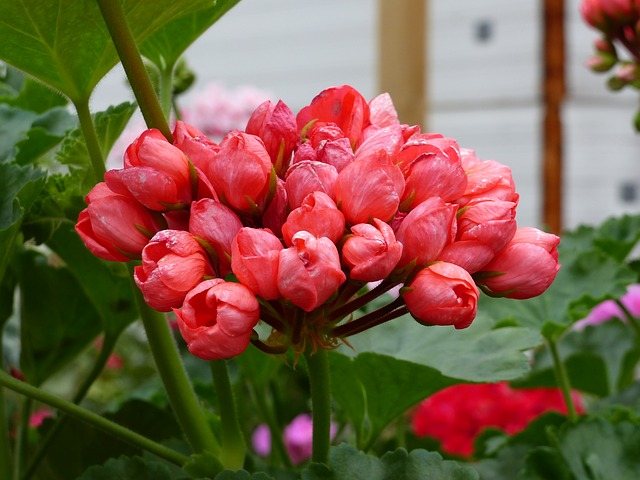

Classification
Zonal pelargonium is a genus numbering about 70 thousand varieties. Some old varieties and hybrids have already been lost. Plants are divided into subgroups according to several characteristics..
To size:
- microminiature - less than 10 cm in height;
- miniature - 10-13 cm;
- dwarf - 13-25 cm;
- medium (normal) - 25-60 cm;
- tall (Irene) - up to 80 cm.
By the structure of the flower:
- non-double - 5 petals are located in one row;
- semi-double - 6-8 petals;
- terry - more than 8 petals, which are located in several rows.
By color of flowers:
- plain;
- two-color;
- tricolor:
- speckled;
- "Bird's egg" - with a rounded spot at the bottom of the petal.
By leaf color:
- Common - green leaves with a contrasting zone of a slightly lighter or darker shade.
- Variegated - have two-colored or three-colored brightly colored leaves, green, golden, reddish and dark brown tones with spots and strokes.
By the shape of the flower and inflorescence:
- rosaceous (rosaceous);
- tulip-shaped;
- carnation;
- cactus;
- star-shaped;
- deacons ("Deacons").
Rosaceae - zoned pelargoniums with double flowers, which are very similar to miniature roses.
Tulip - Plants form flower stalks with lush "bouquets of tulips". Semi-double or double flowers do not fully open, retaining the shape of a tulip bud.
Carnation - have large petals with jagged edges.
Cactus - Pelargonium flowers are similar to cactus flowers, the petals are similar to those of dahlias and needle chrysanthemums, often twisted into tubes.
Star-shaped - flower petals have a sharp, angular shape.
"Deacons" - hybrids of zonal and ivy geraniums with large flowers. They bloom profusely, inflorescences and bushes are compact.
TOP of the best varieties of flowers
Pelargonium Fischers Appleblossom
Talking about zonal pelargonium, it is also worth mentioning its best varieties:
- Pink (or double) grade. As the name implies, the flower looks like a rose. As a rule, large flowers are pink in color. They are distinguished by drought resistance. Used for landscaping.
- Tulip-like. This varietal species is distinguished by its very abundant flowering. It was bred in the second half of the 20th century and almost immediately became one of the most popular flower beds in Europe.
- Cactus. A particularly interesting plant. Among others, it stands out for its twisted inflorescences. The varietal species has flowers longer than other geraniums. The flower bush looks from the outside rather shaggy, similar to a cactus flower.
- Deacon. A very good and flavorful variety. It has flowers of pink, orange or red color. The flowers themselves are small in size, but very tightly collected in neat small inflorescences.
- Star-shaped. It was developed as a separate variety in the second half of the 20th century. The flowers of the plant are white, have elongated and sharp edges (hence the name of the plant).
Reproduction of geranium-pelargonium
Pelargonium (geranium) reproduces well dividing the bush
... This is the simplest and most common way. Can be propagated in spring
cuttings
... I tried to propagate by cuttings and in the fall. It worked too. The stalk (the cutest and thickest piece of the stem, 10-15 cm long) was simply put in a glass of water, and as the roots appeared and grew, she transplanted the young plant into a pot with soil. But I don't really like cuttings. With this method of reproduction, many plants die in me. Although it is believed that pelargonium is easily propagated by cuttings. Apparently, I lack experience in this breeding method, so I prefer to propagate geranium by dividing the bush. With this method, I never had any attacks.


Lighting
When growing pelargonium, it must be remembered that these are light-loving plants. Planted in the open ground or taken out into the open air for the summer, they perfectly tolerate direct sun. The exception is royal pelargoniums, which are more picky about the effects of wind and rain, so it is preferable to grow them on terraces, balconies and window sills, in sheltered places. If pelargonium is placed indoors (in a greenhouse, on a window), where light enters through glass, the plant may overheat, especially in conditions of poor ventilation. Then you need protection from the scorching summer midday sun. It will take out pelargonium and a little shading, but with a lack of light, the lower leaves will begin to turn yellow and die off, the stem will be bare, the plant will not bloom.
|
It is important to regularly, once every few days, turn the plant at a small angle relative to the light source, this is necessary for uniform crown growth.
What is pelargonium zonal, what varieties exist, what is needed for growing care?
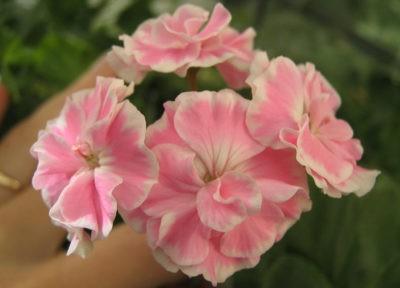

Not sure how and what you can decorate a window sill with to make it look like a small but cozy greenhouse? Pelargonium will easily help you with this - a flower that can cheer you up with its appearance and long flowering.But like any flower, this beauty requires certain care and compliance with the correct conditions of detention.
In this article, we will explain in detail how to grow this beautiful flower and how to properly care for it. Also watch a helpful video on this topic.
Main types
Aromatic Pelargonium (Pelargonium graveolens)


This evergreen, pubescent shrub is highly branched and can reach a height of 100 centimeters. The green pubescent leaves are divided into 5–7 lobes and have a very pleasant aroma. Umbrella-shaped inflorescences consist of a large number of pinkish flowers. Blooms throughout the summer.
Pelargonium capitatum


This plant is an evergreen shrub, the height of which does not exceed 50 centimeters. There is pubescence on the surface of the stems and leaves. The stems are straight. Green, as if crumpled, leaves are divided into 3-5 parts. The inflorescence is in the shape of an umbrella. There are many sessile flowers, colored light pink with a purple tint. Flowering is observed from mid to late summer. Possesses fragrant foliage.
Fragrant Pelargonium (Pelargonium odoratissimum)


The foliage of this shrub does not fall off, and its stems are rather short. Rounded-heart-shaped leaves can be up to 5 centimeters wide. Their edges are slightly torn, and there are soft short hairs on the surface. The foliage is very aromatic and the scent is quite pleasant. Inflorescences in the form of umbrellas. Whitish-pink flowers are collected in 8-10 pieces.
Pelargonium zonale


These shrubs reach a height of 100 centimeters. There is pubescence on the surface of their fleshy stems. As a rule, the leaf plate is solid, but sometimes it is slightly lobed. The foliage is green with a brownish border around the edge. The flowers are colored red and are collected in multi-flowered inflorescences. Flowering lasts from late spring to early autumn.
Pelargonium nodule (Pelargonium cucullatum)


The homeland of such an evergreen shrub is South Africa. There is pubescence on its surface. Long-petiolate leaves are colored green. Umbrella-shaped inflorescence, composed of many purple-red flowers. The plant blooms from the end of the summer period to the beginning of the autumn. There are varieties with terry foliage.
Pelargonium grandiflorum
It is a highly branching evergreen shrub that can reach a height of 100 centimeters. The kidney-rounded leaves can be either dissected or lobed. They can also be smooth or pubescent. No more than 3 flowers are formed on the peduncle, and they are painted white, and the existing veins are reddish. The diameter of the flowers is 3-4 centimeters. This shrub blooms from mid-spring to early summer.
Pelargonium crispum


Such an evergreen shrub reaches a height of 50 centimeters and is highly branching. Dense heart-shaped leaves growing in 2 rows have serrated, ragged-wavy edges. Flowering is observed from the middle to the very end of the summer period. On short pedicels 2-3 flowers grow. Has thick leaves.
Pelargonium staining (Pelargonium inquinans)
Such a shrub, which is evergreen, can reach a height of 1.5 meters. Has fleshy stems. Rounded buds are dark green. The inflorescences are in the shape of an umbrella. Short stalks. The flowers are red in color. The flowering time depends on the care, and can be observed during the summer, autumn, winter or late spring.
Pelargonium fluffy (Pelargonium crithmifolium)
This deciduous plant is a succulent and has thick, creeping stems. The leaf plate is divided into pinnate lobes, the length of which is 8 centimeters. They have a bluish color and can be either pubescent or without pubescence. Inflorescences are presented in the shape of an umbrella.The length of the pedicels is from 15 to 20 millimeters. Snow-white flowers grow in 5 or 6 pieces, and in the throat they have small reddish spots.
Pelargonium pink (Pelargonium radens)
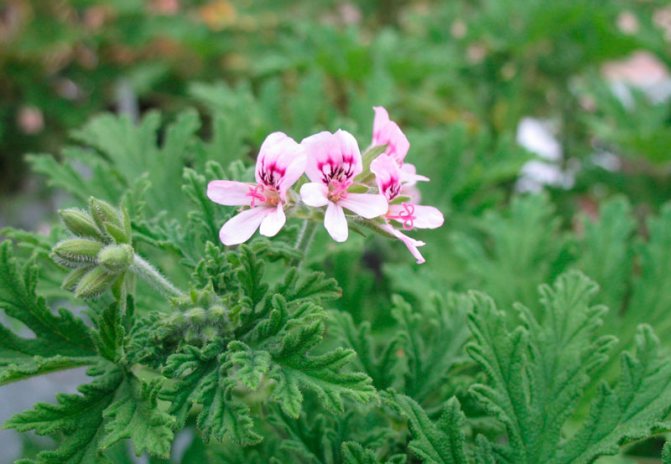

The evergreen highly branching shrub is pubescent and can reach a height of 50 centimeters. There is bilateral pubescence on the leaf plate, while there are hard hairs on the front side, and soft hairs on the seamy side. The leaves are fairly deeply divided and have curved edges. They are fragrant and have a pleasant aroma. The pubescent peduncle is presented in the shape of an umbrella. Several pink flowers with dark veins grow on the peduncle.
Pelargonium angulosum
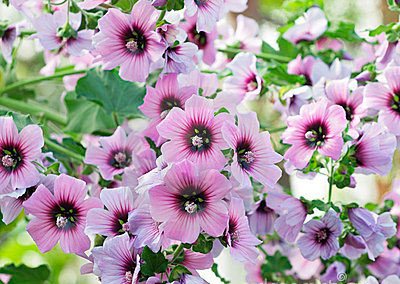

This plant can reach a height of 100 centimeters. The foliage is similar in shape to oak leaves, but the lobes are not straight, but wavy. They are short petiolate. The inflorescence is in the shape of an umbrella, and it consists of a large number of flowers, usually colored deep red. If you take care of the plant correctly, then it will bloom from the end of the summer to the middle of the fall.
Pelargonium tetragonum


This deciduous shrub can reach a height of 0.6–0.7 meters. Tetrahedral straight shoots are pale green, sometimes with a grayish tinge. On the surface of the heart-shaped leaflets, there are sparse hairs. Their width is usually 5 centimeters. The edges of the leaf plate are brownish red. The flowers have 5 pinkish or creamy petals, with 2 smaller ones at the bottom and 3 larger ones at the top.
Pelargonium corymbose (Pelargonium peltatum)


This evergreen shrub is ampelous. The stems are glabrous or pubescent. The green, shiny, fleshy leaves have a thyroid shape, smooth edges and are divided into 5 lobes. On their surface, there may or may not be pubescence. Flowers are collected in several pieces in umbrella-shaped inflorescences. They are pink, white or red in color. Flowering lasts from mid-spring to late summer.
Growing tips
- Since the plant is native to Africa, it needs bright light 15-16 hours a day for abundant flowering. Both the west and east sides of a house with a window will do. The light should be bright, diffused. Protect the flower from burns.
- The seeds of this plant are usually sown in fairly loose soil. This soil consists of turf, peat and sand in a ratio of 2: 1: 1. This mixture does not need to be overfilled with nutrients, as this will only harm the seeds. Also, do not forget about disinfecting the soil, for example, it can be heated in an oven at a sufficiently high temperature.
- After the seedlings have begun to sprout, you need to periodically loosen the soil. Our soil must be moistened, but do not overdo it. The future plant should be placed on a window, well-lit by the rays of the sun, and maintained at a moderate temperature.
- With the first leaves, seedlings must be dived into small pots. After that, the plants should be stored at a temperature of 17-20 degrees.
1. Seven Secrets of Success:
| 1. Growing temperature: zonal pelargonium adores daily temperature fluctuations - if during the day the air temperature can be 18-24 ° C, then at night it is worth providing a cool atmosphere with a temperature of 13-16 ° C. In winter, it is advisable to provide a cool dormant period at a temperature of about 10 ° C. |
| 2. Lighting: tolerates direct sunlight falling on the leaves in the morning and evening, a light shade takes place during the daytime in spring and summer. |
| 3. Watering and humidity: regular watering with a little drying of the topsoil 2 - 3 cm thick during spring and summer. Reduce watering in accordance with the temperature of the room in the fall and winter. Sufficiently high air humidity. |
| 4. Pruning: Remove old buds to extend flowering time, prune pelargonium to maintain a neat bushy shape and form lateral shoots. |
| 5. Priming: loose and nutritious peat-based soil with good drainage, with sufficient organic content. Plants thrive in a wide variety of substrates. |
| 6. Top dressing: in the warm season with complex mineral fertilizers 2 times a month. In autumn, fertilizing is reduced and in winter the plants are immersed in a dormant period, refusing to fertilize the flower. |
| 7. Reproduction: stem and apical cuttings, which root quite successfully in spring and summer, are sometimes grown from seed. |
Botanical name: Pelargonium x hortorum.
Family... Geranium.
Homeland of the plant... South Africa.
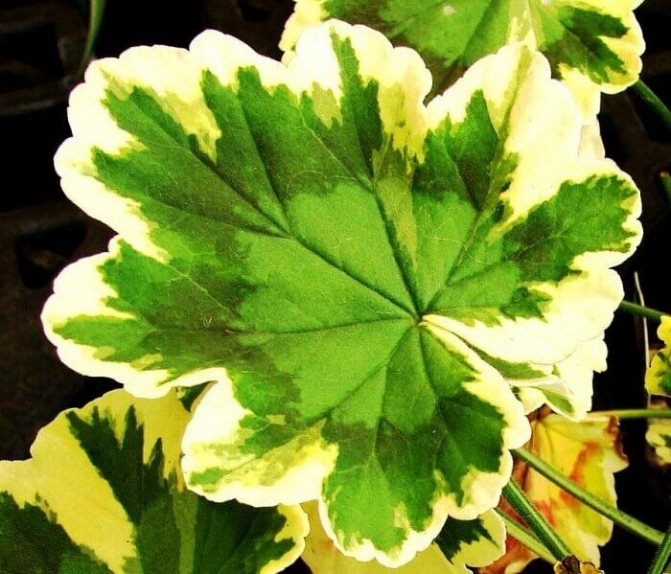

Description. The name of the zonal pelargonium comes from the peculiar dark circles on the rounded leaves of the plant. The shoots of the flowers are strong, branched, lignify with age and are covered with light brown bark. A very large and diverse group of plants with large, brightly colored inflorescences - umbrellas with spectacular flowers. Flowers can be simple, semi-double or double in a variety of shades of pink, salmon, red, purple or white.
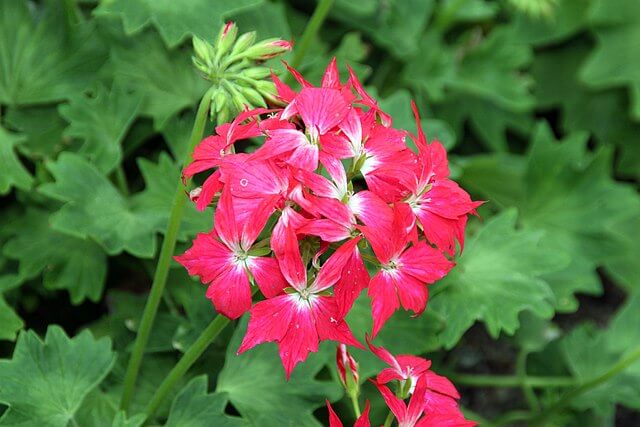

It is not uncommon for zonal pelargonium flowers to be colored in 2 contrasting shades. Leaves are green, 7 to 10 cm in diameter, slightly pubescent, alternately arranged on long petioles. Small variegated varieties are available. The shape of the leaf plates, depending on the variety, can be different. At present, pelargonium is included in a separate genus of the Geranium family. When damaged, all parts of the plant give off a bright aroma, often with fruity notes.
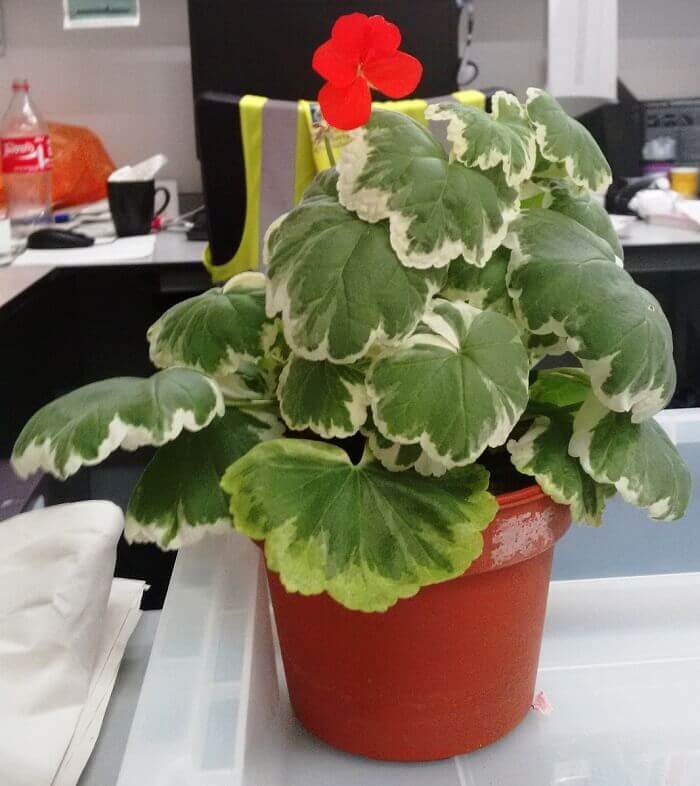

Height... Depends on the variety, 15 - 90 cm. Plants develop quickly enough and within one season they can add 20 - 30 cm. Growth.
Possible problems
Due to the intricacies of care, which are not followed by all growers, there are problems with flowering, growth, overgrowth of green parts of the plant, etc.
Does not bloom


There are many reasons for the lack of flowering in pelargonium.
The most basic ones are:
- excess nitrogen in soil and fertilizers;
- excess moisture in the air;
- too dry air;
- excessive watering;
- lack of minerals;
- overgrowth of the flower without long-term rejuvenation;
- improper maintenance in winter.
Most often, the lack of flowering is caused by a complex of reasons. The plant, although unpretentious in care, requires a certain amount of attention. Otherwise, you can get either a green bush or a bare stem.
We suggest watching a video about why pelargonium does not bloom:
Pests and diseases
- Blackleg appears when waterlogged, excessively dense soil, as well as when using contaminated soil. It is impossible to save the plant, the only way out is to cut off the still living shoots, and throw out the stem, root and earth.
- Gray mold appears with excessive humidity. The affected leaves are removed, the plant is treated with antifungal agents and transferred to a drier place.
- Sometimes plants are attacked whiteflies and spider mites. To combat them, chemicals are used, they are treated 2-3 times to completely destroy all eggs and larvae that could survive after the initial treatment.
- To combat blackleg, the soil is treated with Fitosporin before planting, or with a solution of potassium permanganate (3 g per 10 liters of water).
- Treatments with Ronilan, Rovral, Topsin M and other antifungal drugs in the concentration indicated on the package help against gray mold.
- Fitoverm, Actellik, Sunmight and others help against spider mites and other pests.
More information about diseases and pests of pelargonium can be found here.
Pelargoniums are widespread for their unpretentiousness and flowering. The essential oils secreted by them have a bactericidal effect, heal the air in the room, and lead to harmony in the psychological climate. Proper care will ensure an active and powerful flowering every year.
For the successful cultivation of different types of pelargonium, we suggest that you familiarize yourself with the following articles:
- Growing in the garden.
- Medicinal properties.
- Reproduction methods - cuttings and seeds.
- Leaf diseases and yellowing.
Physiological disorders not associated with diseases or pests
- Reddening of the leaves... The reason is too low temperature. The conditions of detention must be changed.
- The plant does not bloomalthough his general condition is good. The reason may be too high a temperature, lack of light or excessive watering.
- The leaves turn yellow and fall off, the edges of the leaves dry... The reason may lie in insufficient watering, with a strong exposure of the stem, in a lack of light.
|
Photo: Nina Starostenko, Rita Brilliantova

